Strategic Siting of Direct Air Capture Facilities in the United States
Abstract
:1. Introduction
2. Methods
2.1. Cost of CO2 Removal (COCR)
2.1.1. Net CO2 Removed
2.1.2. T&S Costs
2.2. DAC Favorability Index
3. Data
3.1. Techno-Economic Data
- Capacity and Cost: L-DAC (Case 1) has a significantly larger capture capacity (~10×) and higher associated total operating cost (TOC) compared to sorbent-based DAC before scaling (Cases 2a and 2b).
- Technology Stage: All three configurations represent sample designs. As both technologies undergo further research, development, and demonstration, optimal configurations and cost reductions are likely.
- Sorbent Generalization: The sorbent characteristics used (Cases 2a and 2b) reflect an average of reported material performance across the literature and do not represent a specific material or approach [12].
3.2. DAC Performance
3.3. Study Spatial Scope
3.3.1. Local Temperature and Humidity Variations
3.3.2. Emissions from Regional DAC Power and Energy Sourcing
3.3.3. Regional Decarbonization Commitments
3.3.4. Regional Adoption of Wind and Solar Technologies
4. Results
4.1. DAC Performance
4.2. Net CO2 Removal
4.3. CO2 T&S Costs
4.4. Cost of CO2 Removal (COCR)
Sensitivity Analysis: CO2 Concentration
4.5. DAC Favorability Index
5. Discussion
6. Conclusions
Author Contributions
Funding
Data Availability Statement
Acknowledgments
Conflicts of Interest
Disclaimer
Appendix A
| Project Name | DAC Provider | Location | Technology | Capacity (Tonnes/Year) | Entities | Status |
|---|---|---|---|---|---|---|
| Heirloom Carbon Technologies | Heirloom Carbon Technologies | Tracy, CA | Solvent and sorbent | 1000 | Heirloom, CarbonCure Technologies, Breakthrough Energy Ventures | Operating  [41] [41] |
| Farley DAC Project | AirCapture LLC | Columbia, AL | Sorbent | 5000 | Battelle, Southern Company | Planning  [40] [40] |
| University of Illinois | Climeworks | Brawley, CA | Sorbent | 5000 | University of Illinois | Planning  [40] [40] |
| Constellation | Carbon Engineering | Byron, IL | Solvent | 5000 | Constellation, Carbon Engineering | Planning  [40] [40] |
| University of Illinois | CarbonCapture | Gary, IN | Sorbent | 5000 | University of Illinois, CarbonCapture Inc., CarbonCure | Planning  [40] [40] |
| Nutrien’s Kennewick Fertilizer | AirCapture LLC | Kennewick, WA | Sorbent | 5000 | AirCapture LLC, Nutrien | Planning  [40] [40] |
| Project Monarch | Capture6 | Palmdale, CA | Solvent (saltwater) | Pilot | Capture6, Palmdale Water District | Planning  [42] [42] |
| Southwest Regional Direct Air Capture Hub | CarbonCapture | Phoenix, AZ | Sorbent | 1 million | Arizona State Univ., Black & Veatch, Carbon Collect, CarbonCapture, Carbon Solutions, Proton Green, Univ. of New Mexico, Univ. of Utah, Tallgrass, Arizona Geological Survey | Planning  [43] [43] |
| CalHub | Climeworks | Kern County, CA | Sorbent | 1 million | EPRI, California Resources Corporation, Climeworks, Avnos, SoCalGas, Kern Com College District, NREL LLNL, Univ. of Michigan, Cal. State Univ., Bakersfield | Planning  [42] [42] |
| Southeast DAC Hub | AirCapture LLC | Peachtree Corners, GA | Sorbent | 1 million | Southern States Energy Board, Alabama Power Company | Planning  [42] [42] |
| Project Cypress | Climeworks, Heirloom | Calcasieu Parish, LA | Sorbent | 1 million | Battelle, Climeworks Corporation, Heirloom Carbon Technologies | Planning  [44] [44] |
| Prairie Compass DAC Hub | Climeworks | Grand Forks, ND | Sorbent | 1 million | University of North Dakota Energy & Environmental Research Center | Planning  [42] [42] |
| South Texas DAC Hub | Carbon Engineering | King Ranch, Kleberg County, TX | Solvent | 1 million | 1PointFive | Planning  [44] [44] |
| Wyoming Regional Direct Air Capture Hub Project Bison | CarbonCapture | Sweetwater County, WY | Sorbent | 200,000 | Carbon Capture Inc., Frontier Carbon Solutions, Twelve, Univ. of Wyoming, Fluor, Carbon Direct, INTERA, EPRI, Carbon-Based Consulting, Icarus, Novus Energy Advisors | Planning  [42] [42] |
| Stratos DAC Project | Carbon Engineering | Permian Basin, TX | Solvent | 500,000 | Oxy/1PointFive, BlackRock | Under construction [33] |
| Region of Consumption | 2.5% Confidence Interval | Average Case | 97.5% Confidence Interval |
|---|---|---|---|
| Pacific (PA) | 7.2 | 12.2 | 18.9 |
| Rocky Mountain (RM) | 5.2 | 8.6 | 13.2 |
| Southwest (SW) | 6.9 | 11.7 | 17.8 |
| Southeast (SE) | 6.4 | 9.8 | 14.1 |
| Midwest (MW) | 6.8 | 10.9 | 16.1 |
| Northeast (NE) | 4.6 | 6.7 | 9.4 |
| U.S. Average | 7.2 | 10.8 | 15.4 |
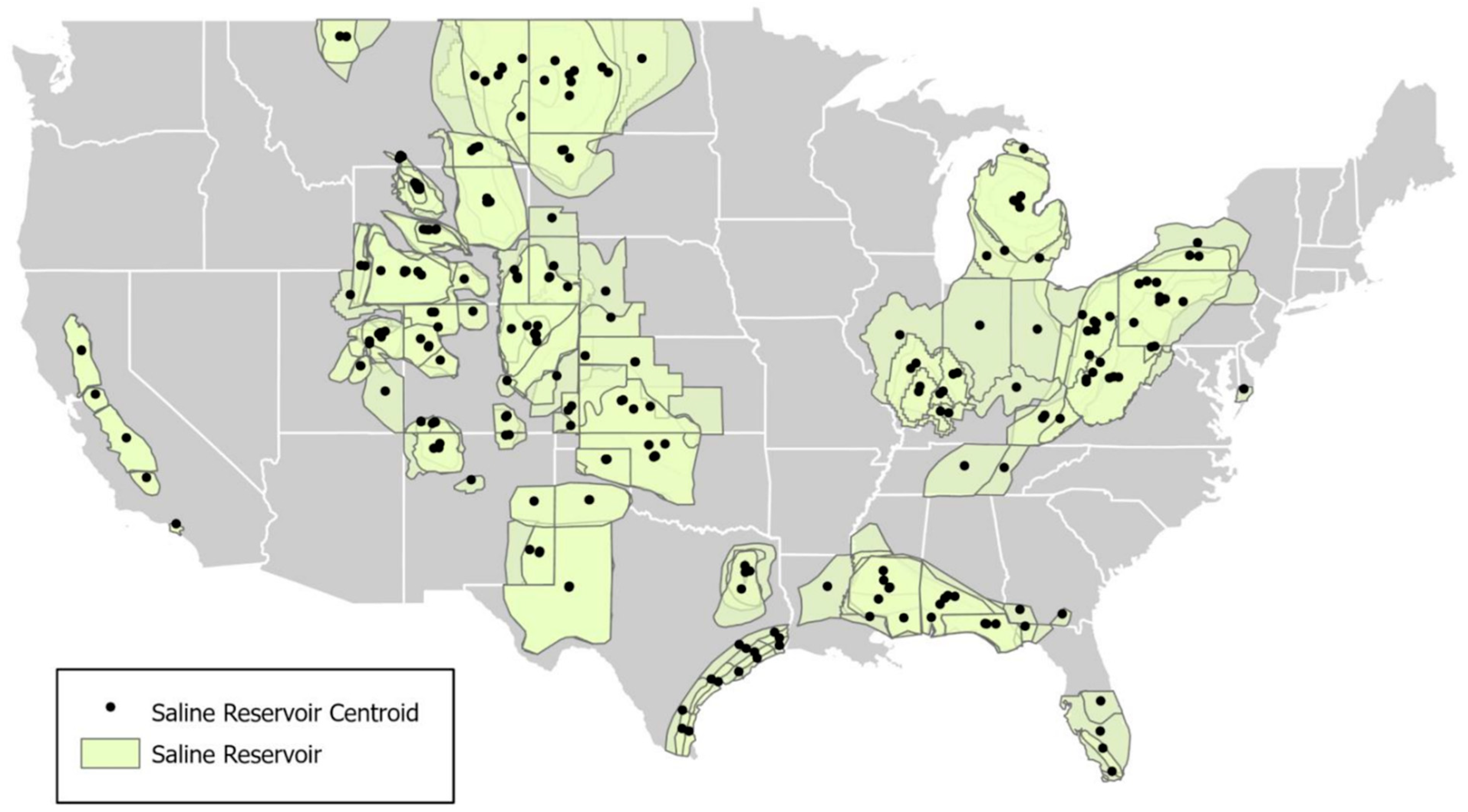
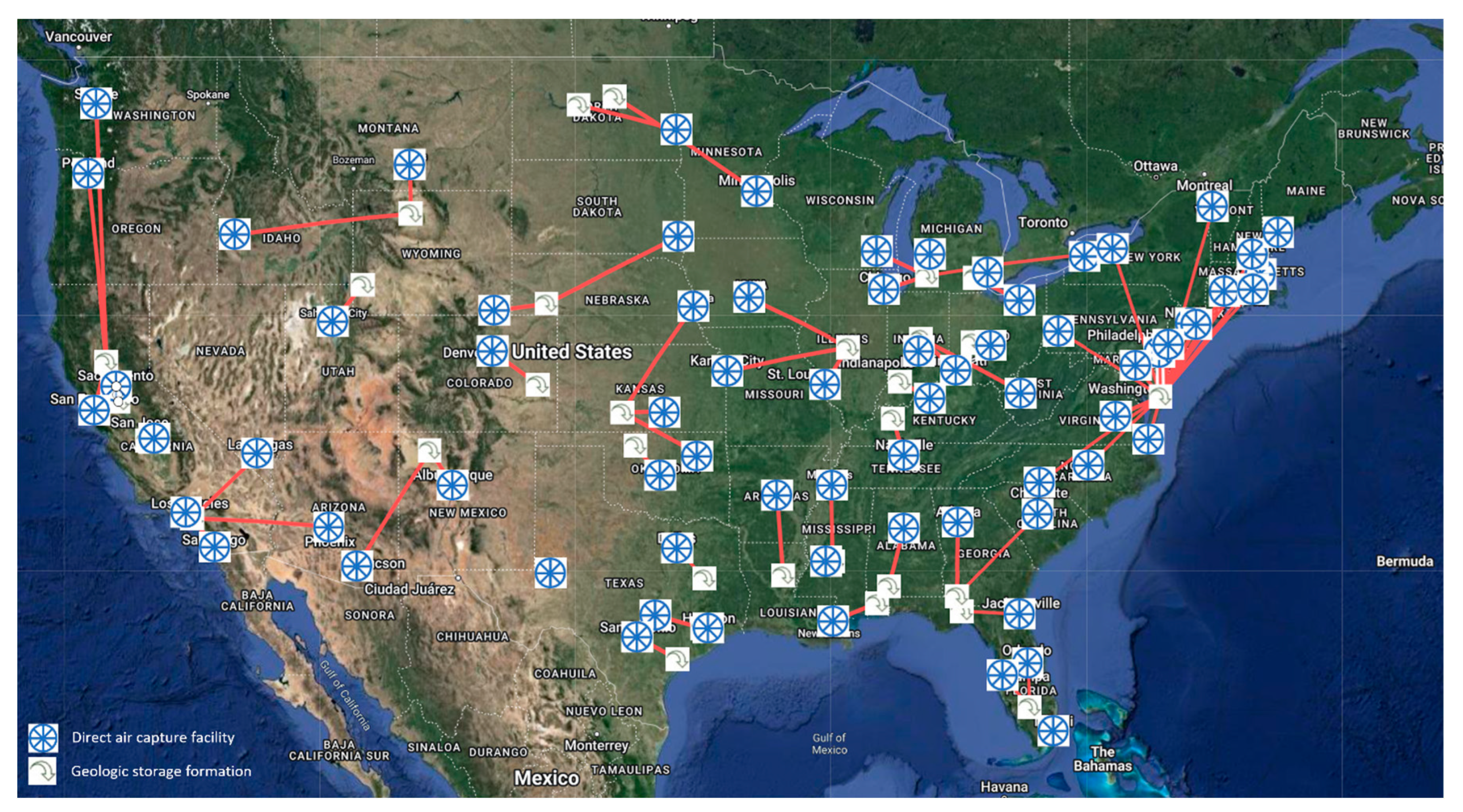
Appendix B. Correlation Analysis for Proxy Variables in Feasibility Index
| State | V1 = Decarbonization Commitment by a Future Year [32] | V2 = Number of Decarbonization-Related Policies and Incentives by State [31] |
|---|---|---|
| California | 100% | 154 |
| Colorado | 100% | 98 |
| Connecticut | 100% | 50 |
| Hawaii | 100% | 31 |
| Illinois | 100% | 65 |
| Louisiana | 100% | 22 |
| Maine | 100% | 27 |
| Maryland | 100% | 74 |
| Massachusetts | 100% | 80 |
| Michigan | 100% | 48 |
| Minnesota | 100% | 132 |
| Nebraska | 100% | 19 |
| Nevada | 100% | 28 |
| New Jersey | 100% | 50 |
| New Mexico | 100% | 40 |
| New York | 100% | 95 |
| North Carolina | 100% | 68 |
| Oregon | 100% | 100 |
| Rhode Island | 100% | 29 |
| Virginia | 100% | 45 |
| Washington State | 100% | 81 |
| Washington, DC | 100% | 51 |
| Wisconsin | 100% | 49 |
| Vermont | 80% | 72 |
| Alaska | 50% | 17 |
| Delaware | 40% | 31 |
| New Hampshire | 25% | 43 |
| Kansas | 20% | 12 |
| Utah | 20% | 27 |
| Pennsylvania | 18% | 61 |
| Arizona | 15% | 51 |
| Missouri | 15% | 60 |
| Montana | 15% | 25 |
| Oklahoma | 15% | 31 |
| Indiana | 10% | 60 |
| North Dakota | 10% | 14 |
| South Dakota | 10% | 19 |
| Texas | 10% | 114 |
| Ohio | 9% | 39 |
| South Carolina | 2% | 39 |
| Alabama | 0% | 19 |
| Arkansas | 0% | 29 |
| Florida | 0% | 72 |
| Georgia | 0% | 35 |
| Idaho | 0% | 32 |
| Iowa | 0% | 46 |
| Kentucky | 0% | 25 |
| Mississippi | 0% | 21 |
| Tennessee | 0% | 15 |
| West Virginia | 0% | 8 |
| Wyoming | 0% | 19 |
| Value | |
|---|---|
| Pearson’s R | 0.42 |
| Number of pairs | 51 |
| Degrees of freedom | 49 |
| T-value (2-tailed) | 3.204467 |
| Determination of significance (p-value) | 0.002381 |
References
- IPCC. Climate Change: A Threat to Human Wellbeing and Health of the Planet. Taking Action Now Can Secure Our Future. Available online: https://www.ipcc.ch/2022/02/28/pr-wgii-ar6/ (accessed on 5 February 2024).
- IPCC. Chapter 4: Sea Level Rise and Implications for Low-Lying Islands, Coasts and Communities—Special Report on the Ocean and Cryosphere in a Changing Climate. Available online: https://www.ipcc.ch/srocc/chapter/chapter-4-sea-level-rise-and-implications-for-low-lying-islands-coasts-and-communities/ (accessed on 5 February 2024).
- Hilaire, J.; Minx, J.C.; Callaghan, M.W.; Edmonds, J.; Luderer, G.; Nemet, G.F.; Rogelj, J.; del Mar Zamora, M. Negative emissions and international climate goals—Learning from and about mitigation scenarios. Clim. Chang. 2019, 157, 189–219. [Google Scholar] [CrossRef]
- Realmonte, G.; Drouet, L.; Gambhir, A.; Glynn, J.; Hawkes, A.; Köberle, A.C.; Tavoni, M. An inter-model assessment of the role of direct air capture in deep mitigation pathways. Nat. Commun. 2019, 10, 3277. [Google Scholar] [CrossRef] [PubMed]
- U.S. Climate Policy Resource Center: Direct Air Capture. World Resour. Inst. Available online: https://www.wri.org/us-climate-policy-implementation/sectors/direct-air-capture (accessed on 5 February 2024).
- McQueen, N.; Gomes, K.V.; McCormick, C.; Blumanthal, K.; Pisciotta, M.; Wilcox, J. A review of direct air capture (DAC): Scaling up commercial technologies and innovating for the future. Prog. Energy 2021, 3, 032001. [Google Scholar] [CrossRef]
- Carbon Removal. World Resour. Inst. 2023. Available online: https://www.wri.org/initiatives/carbon-removal (accessed on 5 February 2024).
- An, K.; Farooqui, A.; McCoy, S.T. The impact of climate on solvent-based direct air capture systems. Appl. Energy 2022, 325, 119895. [Google Scholar] [CrossRef]
- Sendi, M.; Bui, M.; Mac Dowell, N.; Fennell, P. Geospatial analysis of regional climate impacts to accelerate cost-efficient direct air capture deployment. One Earth 2022, 5, 1153–1164. [Google Scholar] [CrossRef]
- Meckling, J.; Biber, E. A policy roadmap for negative emissions using direct air capture. Nat. Commun. 2021, 12, 2051. [Google Scholar] [CrossRef] [PubMed]
- National Energy Technology Laboratory. Direct Air Capture Case Studies: Solvent System. Energy Anal. 2022. Available online: https://netl.doe.gov/energy-analysis/details?id=36385f18-3eaa-4f96-9983-6e2b607f6987 (accessed on 11 January 2024).
- National Energy Technology Laboratory. Direct Air Capture Case Studies: Sorbent System. Energy Anal. 2022. Available online: https://www.netl.doe.gov/energy-analysis/details?id=d5860604-fbc7-44bb-a756-76db47d8b85a (accessed on 11 January 2024).
- Carnegie Mellon University’s Scott Institute for Energy Innovation. US Power Sector CO2 Emissions Intensity. CMU Power Sect. Carbon. Index. 2023. Available online: https://emissionsindex.org (accessed on 25 January 2024).
- Keith, D.W.; Holmes, G.; St. Angelo, D.; Heidel, K. A Process for Capturing CO2 from the Atmosphere. Joule 2018, 2, 1573–1594. [Google Scholar] [CrossRef]
- Abramson, E.; McFarlane, D.; Jordan, A.; Rodriguez, D.; Ogland-Hand, J.; Holwerda, N. An Atlas of Direct Air Capture: Opportunities for Negative Emissions in the United States; Carbon Solutions: Chicago, IL, USA, 2023. [Google Scholar]
- Song, Y.; Oh, C. Market-pull, technology-push, and regulatory stringency determinants: All in need in firms’ decisions for large-scale demonstration of direct air capture technologies. Energy Res. Soc. Sci. 2023, 106, 103339. [Google Scholar] [CrossRef]
- Littlefield, J.; Rai, S.; Skone, T.J. Life Cycle GHG Perspective on U.S. Natural Gas Delivery Pathways. Environ. Sci. Technol. 2022, 56, 16033–16042. [Google Scholar] [CrossRef] [PubMed]
- Morgan, D.; Guinan, A.; Sheriff, A. FECM/NETL CO2 Transport Cost Model Version 4 (2023); National Energy Technology Laboratory (NETL): Pittsburgh, PA, USA, 2023.
- Morgan, D.; Grant, T. FE/NETL CO2 Saline Storage Cost Model (2017); National Energy Technology Laboratory (NETL): Pittsburgh, PA, USA, 2017.
- U.S. Department of Health and Human Services. Inflation Reduction Act of 2022; U.S. Department of Health and Human Services: Washington, DC, USA, 2022.
- California Air Resources Board. Monthly LCFS Credit Transfer Activity Report for December 2023; California Air Resources Board: Riverside, CA, USA, 2023.
- California Legislative Analyst’s Office. California’s Cap-and-Trade Program: Frequently Asked Questions. Available online: https://lao.ca.gov/Publications/Report/4811 (accessed on 11 January 2024).
- California Air Resources Board. Auction Information. Available online: https://ww2.arb.ca.gov/our-work/programs/cap-and-trade-program/auction-information (accessed on 11 January 2024).
- The Regional Greenhouse Gas Initiative. RGGI, Inc. Available online: https://www.rggi.org/ (accessed on 11 January 2024).
- RGGI CO2 Allowance Tracking System. Transaction Price Report. Available online: https://rggi-coats.org/eats/rggi/index.cfm?fuseaction=reportsv2.price_rpt&clearfuseattribs=true (accessed on 11 January 2024).
- State of Washington Department of Ecology. APCR Auction #2 Summary Report—November 2023. Ecology Publications & Forms. Available online: https://apps.ecology.wa.gov/publications/SummaryPages/2302101.html (accessed on 16 January 2024).
- State of Washington Department of Ecology. Cap and Invest Auctions and Market. Available online: https://ecology.wa.gov/air-climate/climate-commitment-act/cap-and-invest/auctions-and-market (accessed on 16 January 2024).
- Woerter, M.; Stucki, T.; Arvanitis, S.; Rammer, C.; Peneder, M. The adoption of green energy technologies: The role of policies in Austria, Germany, and Switzerland. Int. J. Green. Energy 2017, 14, 1192–1208. [Google Scholar] [CrossRef] [PubMed]
- Kemp, R.; Volpi, M. The diffusion of clean technologies: A review with suggestions for future diffusion analysis. J. Clean. Prod. 2008, 16, S14–S21. [Google Scholar] [CrossRef]
- Clean Energy States Alliance. Table of 100% Clean Energy States. Available online: https://www.cesa.org/projects/100-clean-energy-collaborative/guide/table-of-100-clean-energy-states/ (accessed on 6 March 2024).
- DSIRE. Database of State Incentives for Renewables & Efficiency®. DSIRE. Available online: https://www.dsireusa.org/ (accessed on 13 March 2024).
- Anderson, J.; Yin, I.; Watson, M.; Potter, E.; Kotenko, D. S&P Global Commodity Insights: Energy Security in the Spotlight; S&P Global: New York, NY, USA, 2022. [Google Scholar]
- 1PointFive Holds Groundbreaking for World’s Largest Direct Air Capture (DAC) Plant. 1PointFive. Available online: https://www.1pointfive.com/1pointfive-holds-groundbreaking (accessed on 5 March 2024).
- U.S. Climate Normals|National Centers for Environmental Information (NCEI). Available online: https://www.ncei.noaa.gov/products/land-based-station/us-climate-normals (accessed on 5 February 2024).
- George, K.; Ziska, L.H.; Bunce, J.A.; Quebedeaux, B. Elevated atmospheric CO2 concentration and temperature across an urban–rural transect. Atmos. Environ. 2007, 41, 7654–7665. [Google Scholar] [CrossRef]
- CO2 Science, Origin of the Urban CO2 Dome of Paris, France. Available online: http://www.co2science.org/articles/V7/N1/C3.php (accessed on 5 February 2024).
- CO2 Science, The Urban CO2 Dome of Rome. Available online: http://www.co2science.org/articles/V8/N31/C2.php (accessed on 12 March 2024).
- Direct Air Capture Industry 2024. Available online: https://www.marketsandmarkets.com/PressReleases/direct-air-capture.asp (accessed on 1 March 2024).
- IEA. Direct Air Capture—Energy System. Available online: https://www.iea.org/energy-system/carbon-capture-utilisation-and-storage/direct-air-capture (accessed on 5 February 2024).
- Department of Energy. Biden-Harris Administration Announces $3.7 Billion to Kick-Start America’s Carbon Dioxide Removal Industry; Department of Energy: Washington, DC, USA, 2022.
- Department of Energy. A Transformative Low-Cost Approach for Direct Air Mineralization of CO2 via Repeated Cycles of Ambient Weathering of Metal Oxides Resource Efficiency Efficiency; Department of Energy: Washington, DC, USA, 2022.
- Department of Energy. DOE Announces $1 Million Toward Carbon Dioxide Removal Technology Innovation; Department of Energy: Washington, DC, USA, 2023.
- Office of Fossil Energy and Carbon Management. Project Selections for FOA 2735: Regional Direct Air Capture Hubs—Topic Area 1 (Feasibility) and Topic Area 2 (Design); Office of Fossil Energy and Carbon Management: Washington, DC, USA, 2023.
- Department of Energy. Regional Direct Air Capture Hubs Selections for Award Negotiations Office of Clean Energy Demonstrations; Department of Energy: Washington, DC, USA, 2024.
- Google’s My Maps Feature. Google My Maps. Available online: https://www.google.com/maps (accessed on 15 March 2024).
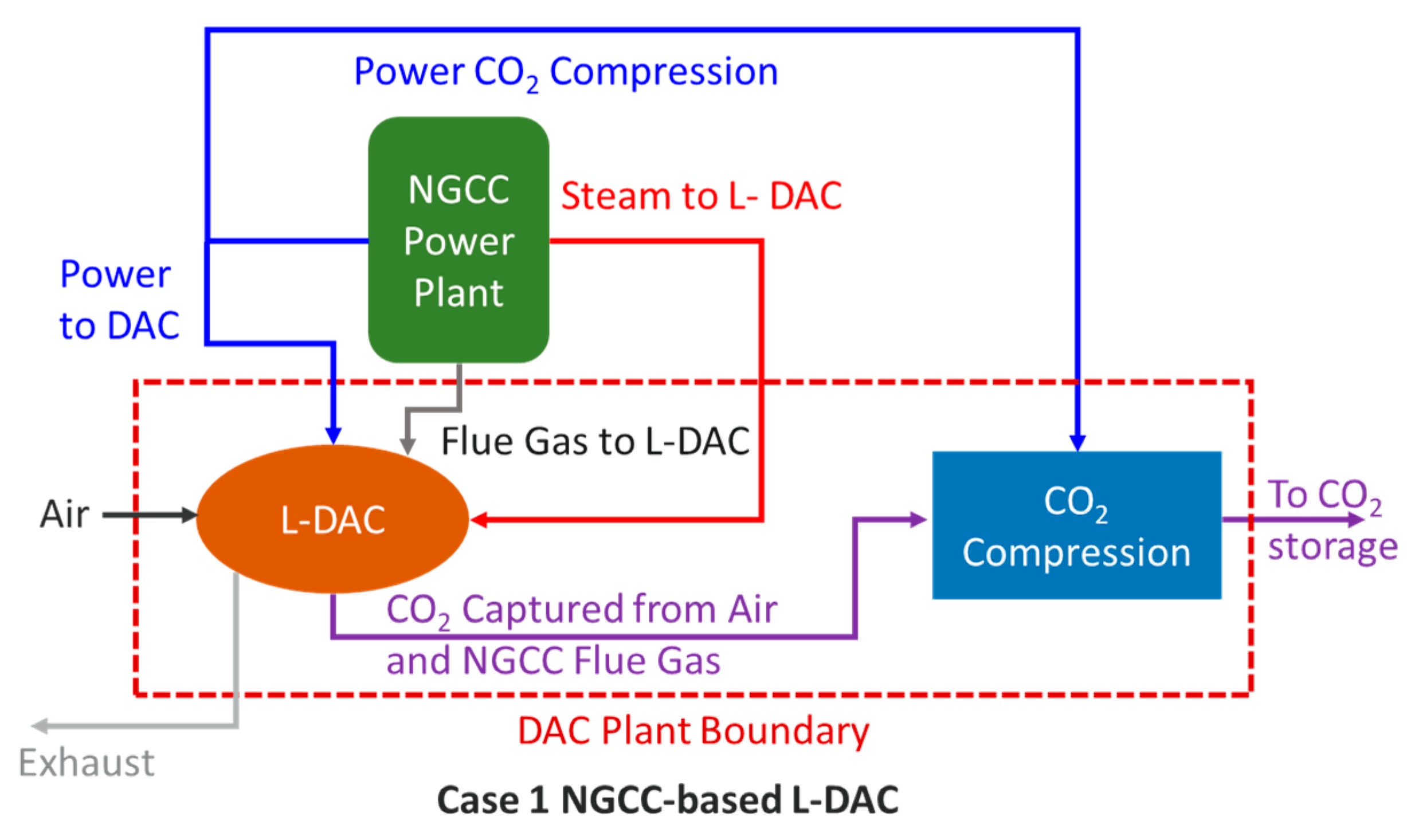

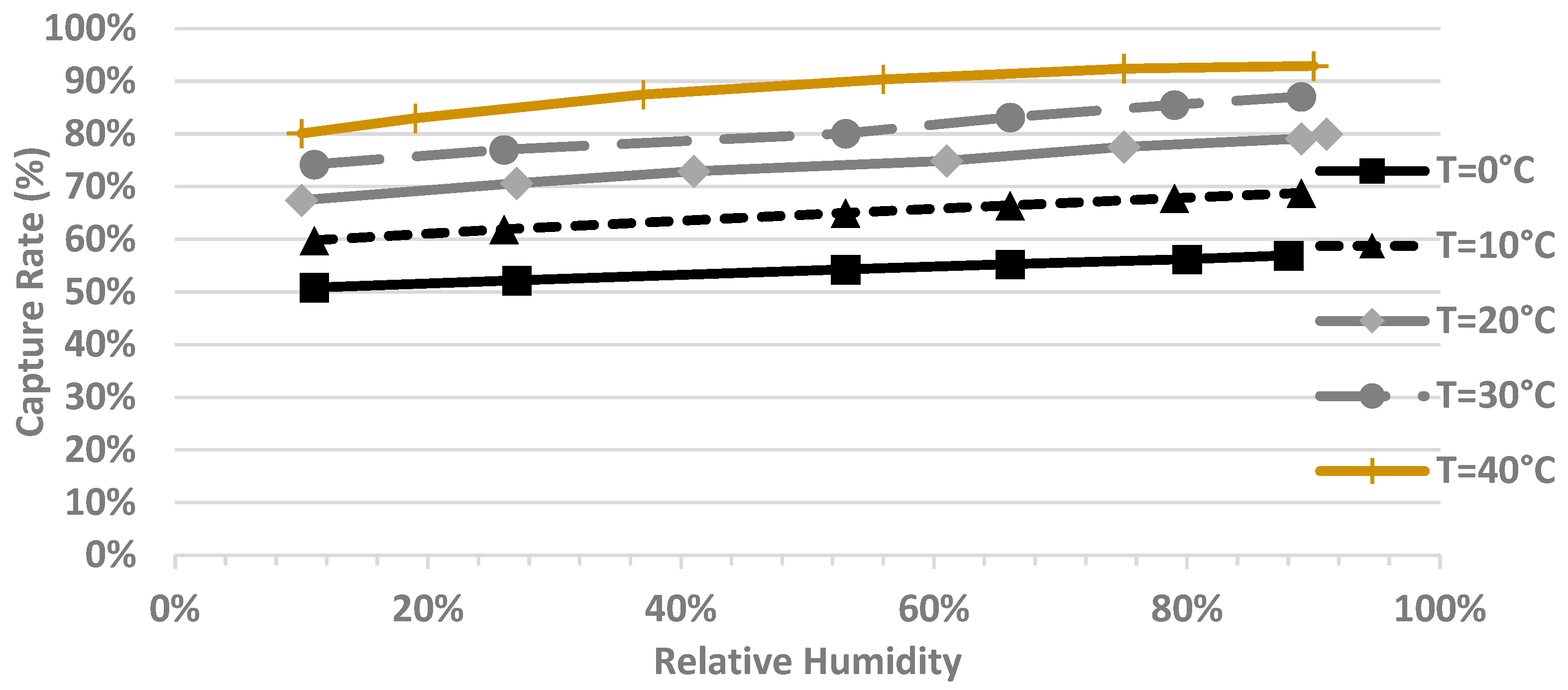

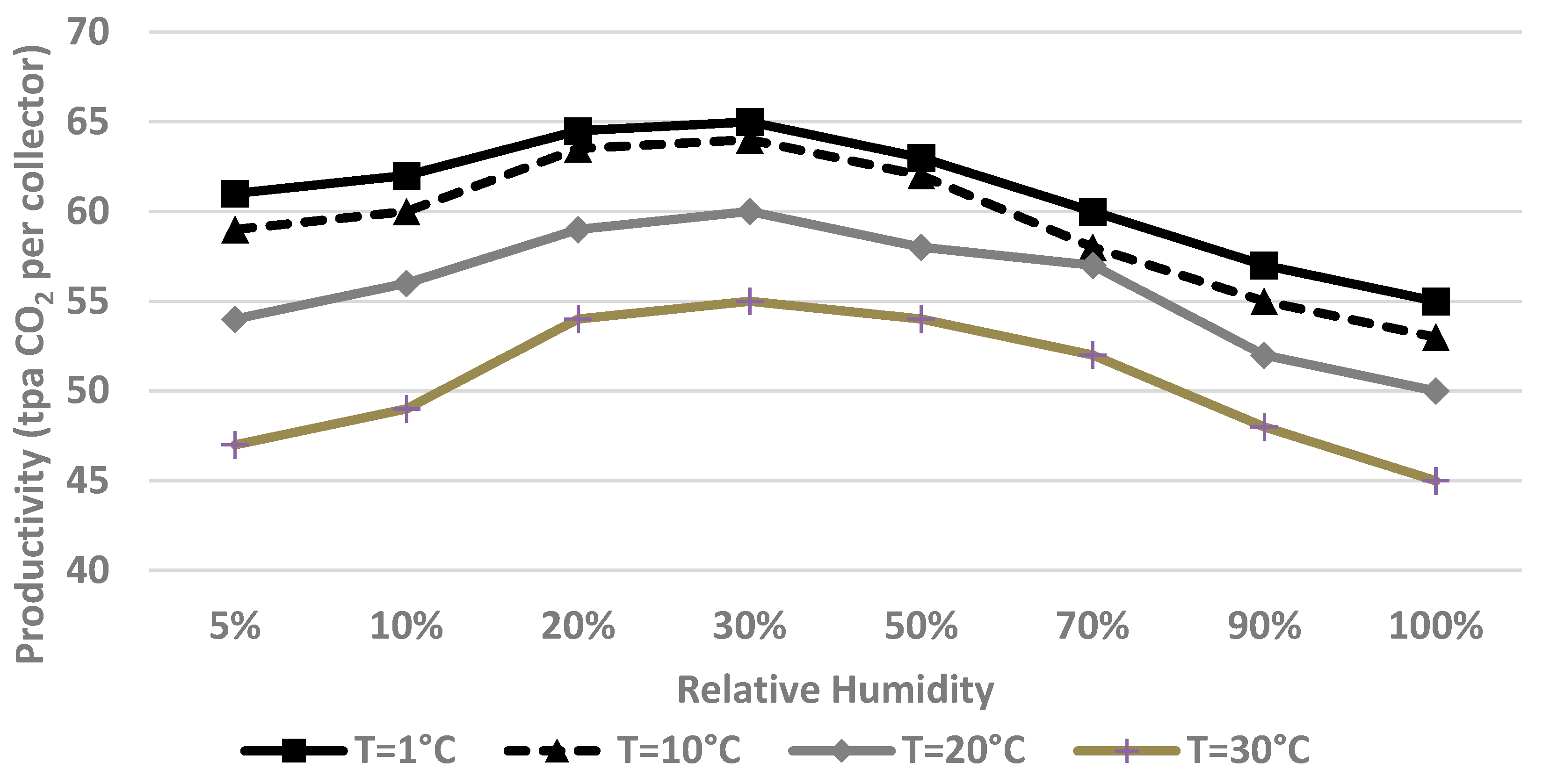

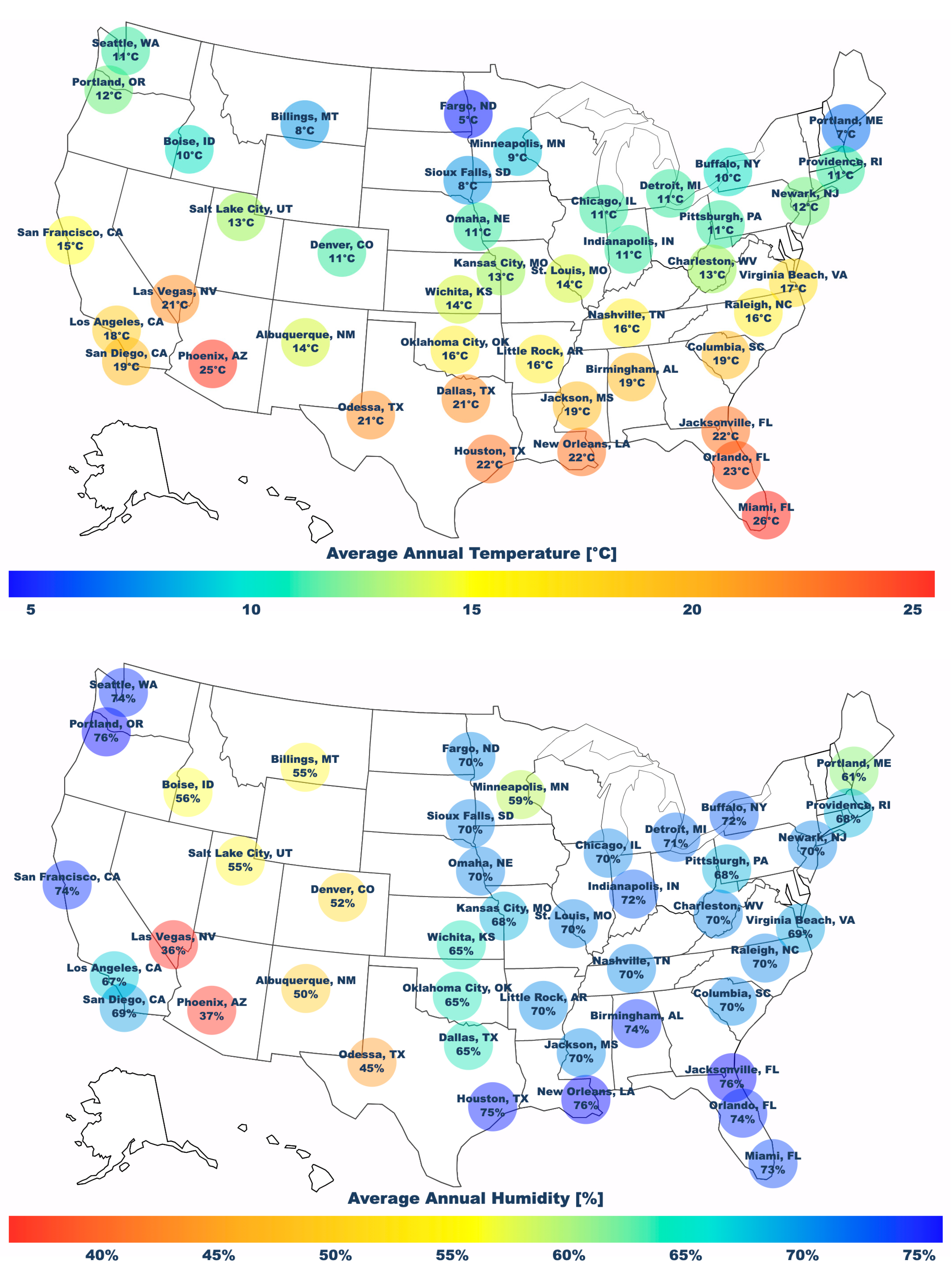
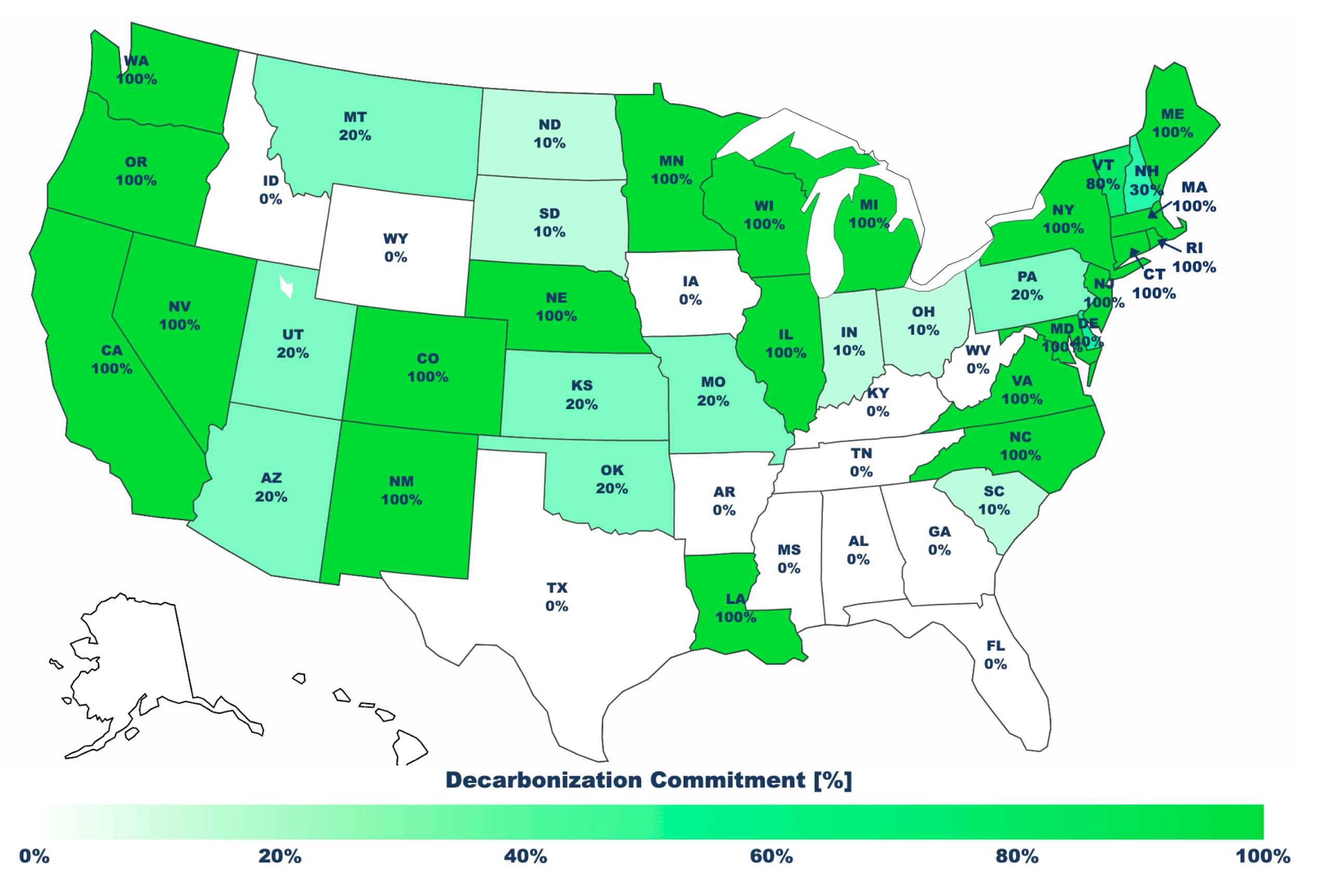






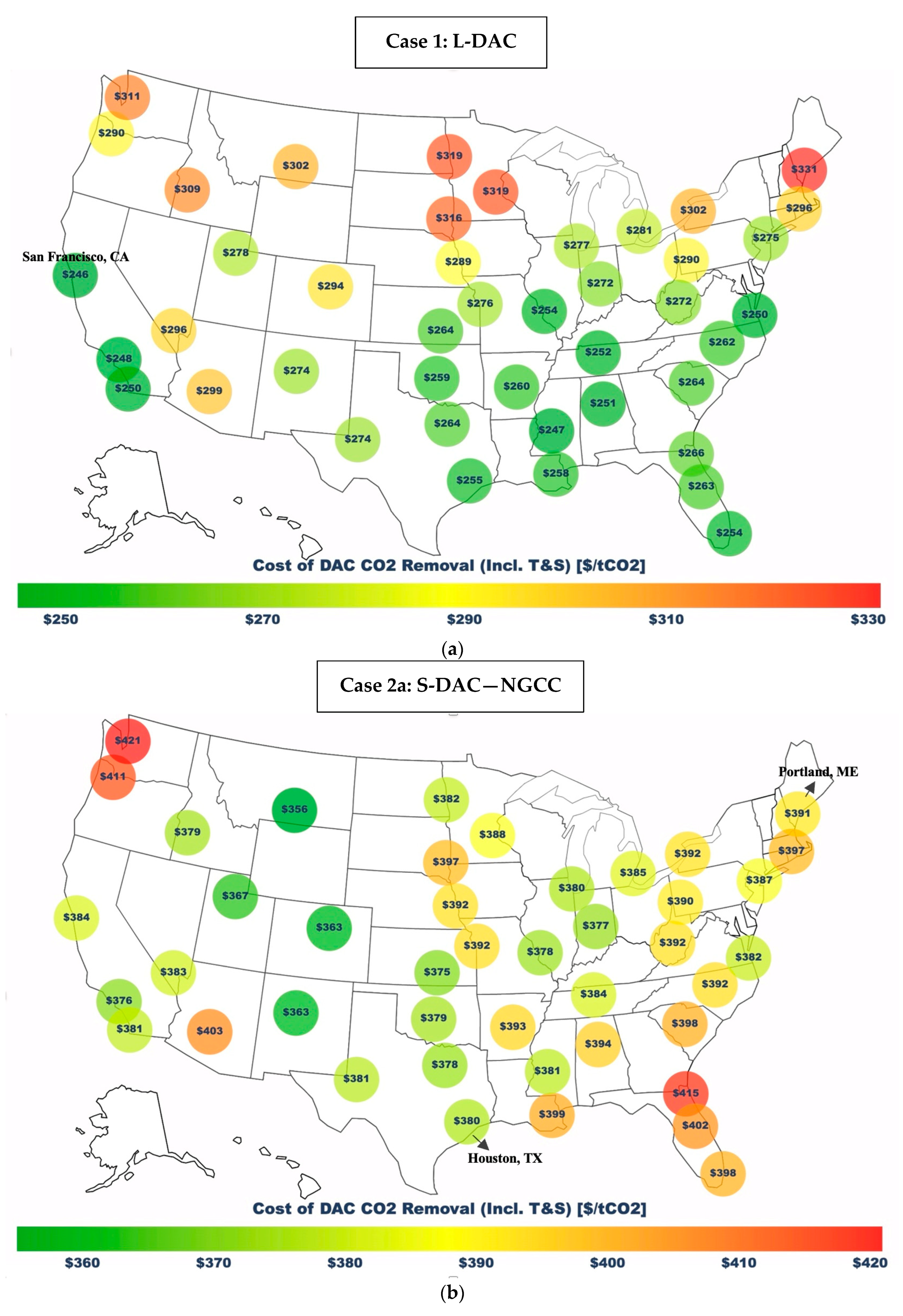





| DAC Technology Case | Name and Description |
|---|---|
| Case 1 Solvent | Potassium Hydroxide (KOH) Solvent represents the L-DAC configuration as described in NETL’s Solvent Case Study [11], with sub-systems primarily modeled based on CE process data. The plant’s auxiliary load, steam, and thermal requirements are supplied by an NGCC plant. |
| Case 2a Sorbent—NGCC | NGCC-based Monolith Absorber is based on the S-DAC approach as outlined in NETL’s Sorbent Case Study [12]. As in Case 1, an NGCC plant supports the DAC plant’s auxiliary load, steam, and thermal requirements. |
| Case 2b Sorbent—Grid-Powered | Grid Electricity-based Monolith Absorber employs the same DAC approach as in Case 2a but uses power from the grid along with an electric boiler to serve both the electrical and thermal requirements [12]. |
| Mechanism | Scope | Takeaway |
|---|---|---|
| Low Carbon Fuel Standard (LCFS) | State (California) | LCFS, developed by the California Air Resources Board, supports DAC deployment anywhere in the U.S. It adds to revenue options at ~USD 75/tonne, with a maximum impact of 369.2 M tonnes CO2e (California’s total GHG emissions in 2020) [21]. |
| U.S. carbon compliance markets | Regional (RGGI, CCT, and WCI *) | DAC cannot participate today but could potentially in the future. There is an upper limit on offsets (3.3% RGGI–4% CCT) for emission reduction obligations. Average auction-clearing prices are USD 12/tonne for RGGI, USD 24/tonne for CCT, and approximately USD 55/tonne for WCI [22,23,24,25,26,27]. |
| 45Q tax credit | Federal | 45Q provides DAC revenue for 12 years, with USD 135/tonne applicable for CO2 utilization and USD 180/tonne for CO2 storage [20]. |
| Voluntary carbon offset markets | Global | DAC is not included in the seven carbon offset registries, but several certification modules are under development. There is strong demand for DAC-captured CO2 from voluntary actors, with prices exceeding USD 400/tonne. |
| Score | Proxy | Indication |
|---|---|---|
| Techno-Economic | City-level cost of CO2 removal | Indicates that the lower the cost of CO2 removal, the more favorable a city is for DAC deployment |
| Policy | State-level decarbonization goals | Indicates that the larger the decarbonization commitment a state has established as a voluntary or enforced goal, the more likely it is to have decarbonization policies in place that could favor carbon direct removal technologies such as DAC |
| Market | State-level market share of wind and solar in the generation market | Indicates that states with a higher adoption of mature decarbonization technologies could be more prepared for the deployment of newer decarbonization technologies, including CDR technologies such as DAC |
| Category | Case 1 [8,14] | Case 2a [9,12] | Case 2b [9,12] | |
|---|---|---|---|---|
| Technical Inputs | DAC technology | L-DAC | S-DAC | |
| Power sources | NGCC | State-average grid mix (from 2022) [13] | ||
| DAC design capacity (tCO2/yr) | 1,000,000 | 113,900 (Scaled to 1,000,000 **) | 100,000 (Scaled to 1,000,000 **) | |
| CO2 concentration (ppm) | 415 | 400 | ||
| Capture rate at baseline climate conditions (%) | 75 | 60 | ||
| CO2 captured from NGCC (calciner (CO2 captured from the calciner is specific to Case 1; it is not applicable to Case 2a, as a calciner is not required) and flue gas) (tCO2/yr) | 502,057 | 125,090 (1,098,244 **) | N/A | |
| CO2 released from flue gas (tCO2/yr) | 5255 | 13,900 (122,037 **) | N/A | |
| Duration of operation (years) | 30 | 10 | ||
| Cost Inputs *** | TOC (million USD) | 1483 * | 350 * | 135 * |
| Fixed annual O&M costs (million USD/yr) | 40 | 15 | 9 | |
| CRF | 0.0707 | |||
| Natural gas cost (USD/GJ) | 4.19 | N/A | ||
| Water cost (USD/gal) | 0.0019 | |||
| Solvent or sorbent cost (USD) | 600/tonne | 4.00/ft3 | ||
| Other annual variable costs (million USD/yr) | 28 | 5 | 2 | |
| State-Level Carbon Intensity of Power Supply in 2022 (kgCO2/MWh) | Exhibited by State(s) | |
|---|---|---|
| Minimum | 0.5 | Vermont |
| Mean | 369 | Florida (closest match) |
| Maximum | 883 | West Virginia |
| Median | 345 | Alabama, Minnesota |
| Standard Deviation | 191.7 | - |
Disclaimer/Publisher’s Note: The statements, opinions and data contained in all publications are solely those of the individual author(s) and contributor(s) and not of MDPI and/or the editor(s). MDPI and/or the editor(s) disclaim responsibility for any injury to people or property resulting from any ideas, methods, instructions or products referred to in the content. |
© 2024 by the authors. Licensee MDPI, Basel, Switzerland. This article is an open access article distributed under the terms and conditions of the Creative Commons Attribution (CC BY) license (https://creativecommons.org/licenses/by/4.0/).
Share and Cite
Boerst, J.; Pena Cabra, I.; Sharma, S.; Zaremsky, C.; Iyengar, A.K.S. Strategic Siting of Direct Air Capture Facilities in the United States. Energies 2024, 17, 3755. https://doi.org/10.3390/en17153755
Boerst J, Pena Cabra I, Sharma S, Zaremsky C, Iyengar AKS. Strategic Siting of Direct Air Capture Facilities in the United States. Energies. 2024; 17(15):3755. https://doi.org/10.3390/en17153755
Chicago/Turabian StyleBoerst, Jason, Ivonne Pena Cabra, Smriti Sharma, Connie Zaremsky, and Arun K. S. Iyengar. 2024. "Strategic Siting of Direct Air Capture Facilities in the United States" Energies 17, no. 15: 3755. https://doi.org/10.3390/en17153755





